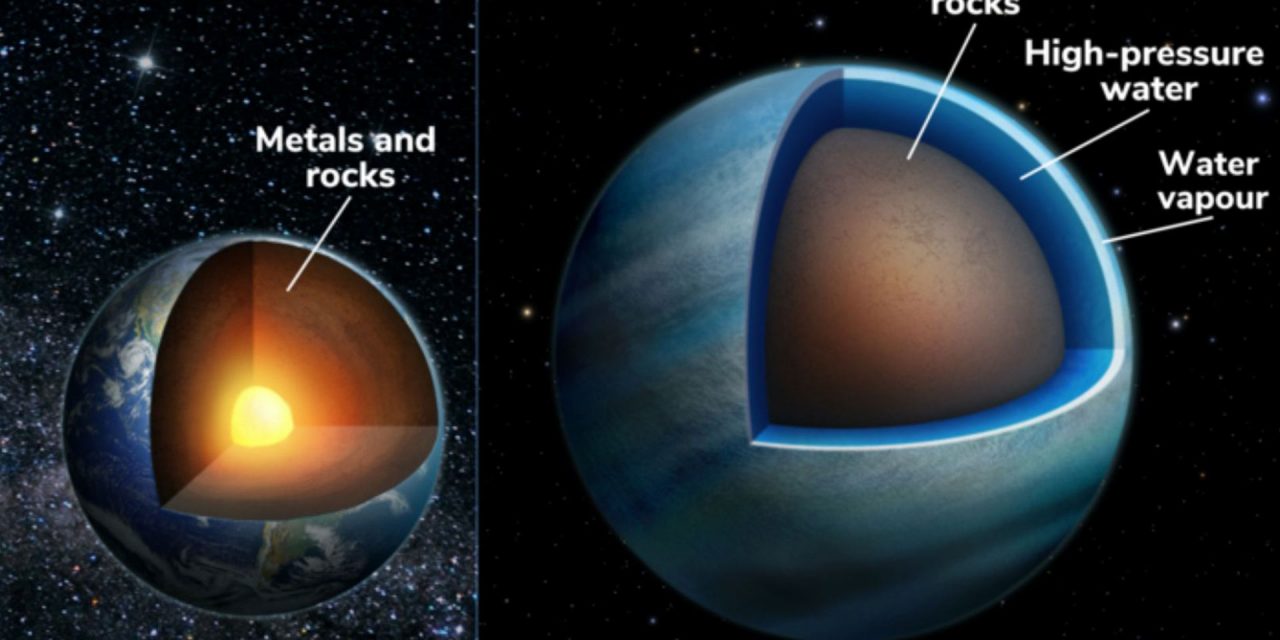Canadian astronomers have discovered that two exoplanets orbiting a red dwarf star are likely to be made up of large amounts of water
A team led by Université de Montréal (UdeM) astronomers has found evidence that two exoplanets orbiting a red dwarf star are ‘water worlds’; planets where water makes up a large fraction of the volume. These worlds, located in a planetary system 218 light-years away in the constellation Lyra, are unlike any planets found in our solar system.
The team, led by PhD student Caroline Piaulet of the Trottier Institute for Research on Exoplanets (iREx) at UdeM, has published a detailed study of a planetary system known as Kepler-138.
Piaulet, who is part of Björn Benneke‘s research team, observed exoplanets Kepler-138c and Kepler-138d with NASA’s Hubble and the retired Spitzer space telescopes, and discovered that the planets – which are about one and a half times the size of the Earth – could be composed largely of water.
These planets and a planetary companion closer to the star, Kepler-138b, had been discovered previously by NASA’s Kepler Space Telescope.
water worlds
Water wasn’t directly detected, but by comparing the sizes and masses of the planets to models, they conclude that a significant fraction of their volume – up to half of it – should be made of materials that are lighter than rock but heavier than hydrogen or helium (which constitute the bulk of gas giant planets like Jupiter). The most common of these candidate materials is water.
Benneke explained: “We previously thought that planets that were a bit larger than Earth were big balls of metal and rock, like scaled-up versions of Earth, and that’s why we called them super-Earths. However, we have now shown that these two planets, Kepler-138c and d, are quite different in nature: a big fraction of their entire volume is likely composed of water.
“It is the first time we observe planets that can be confidently identified as water worlds, a type of planet that was theorised by astronomers to exist for a long time.”
With volumes more than three times that of Earth and masses twice as big, planets c and d have much lower densities than Earth. This is surprising because most of the planets slightly bigger than Earth that have been studied in detail so far all seemed to be rocky worlds like ours. The closest comparison to the two planets would be some of the icy moons in the outer solar system that are also largely composed of water surrounding a rocky core.
Piaulet said: “Imagine larger versions of Europa or Enceladus, the water-rich moons orbiting Jupiter and Saturn, but brought much closer to their star. Instead of an icy surface, Kepler-138 c and d would harbour large water-vapour envelopes.”
dense atmosphere
However, the researchers caution that the planets may not have oceans like those on Earth directly at the planet’s surface.
Piaulet advised: “The temperature in Kepler-138c’s and Kepler-138d’s atmospheres is likely above the boiling point of water, and we expect a thick, dense atmosphere made of steam on these planets.
“Only under that steam atmosphere there could potentially be liquid water at high pressure, or even water in another phase that occurs at high pressures, called a supercritical fluid.”
Recently, another team at the University of Montreal found another planet, called TOI-1452 b, that could potentially be covered with a liquid-water ocean, but NASA’s James Webb Space Telescope will be needed to study its atmosphere and confirm the presence of the ocean.
Benneke concluded: “As our instruments and techniques become sensitive enough to find and study planets that are farther from their stars, we might start finding a lot more water worlds like Kepler-138 c and d.”
The study is published in Nature Astronomy.
Image: Cross-section of the Earth (left) and the exoplanet Kepler-138 d (right). Like the Earth, this exoplanet has an interior composed of metals and rocks (brown portion), but Kepler-138 d also has a thick layer of high-pressure water in various forms: supercritical and potentially liquid water deep inside the planet and an extended water vapour envelope (shades of blue) above it. These water layers make up more than 50% of its volume, or a depth of about 2,000km. The Earth, in comparison, has a negligible fraction of liquid water with an average ocean depth of less than 4km. © Benoit Gougeon, Université de Montréal.










